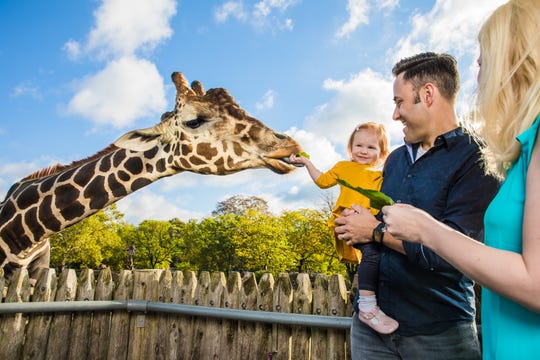In Omaha, I watched a flock of wild turkeys strut across a
meadow. In Phoenix, I walked carefully
around the scurrying spiny lizards, while ground squirrels meandered across the
paths. In Chicago, trumpeter swans
drifted among the heavily planted islands. In Charleston, a mother alligator watched
protectively as her hatchlings bobbed in one of the many water features. Gardens are a great place to watch wildlife…
which makes it surprising that the idea didn’t hit me until Denver.
Shortly before leaving Denver on my recent trip (one which
included visits to Denver Zoo, Downtown Aquarium, and Cheyenne Mountain Zoo), I
decided to squeeze in a visit to the Denver Botanic Gardens before my
flight. I was walking through an
enormous greenhouse, filled with tropical plants, when a bit of movement caught
my eye. Paddling across one of the small
pools there was a small mixed flock of ducks – Brazilian teals and ringed
teals, both handsome little South American species. It was then that an idea clicked with me – if
zoos are incorporating gardens into their campuses, can botanic gardens return
the favor and take some animals?
I’m sure that at the mention of the idea, many botanical
garden curators would cringe at the thought of their lovely landscapes being
ripped up, their acreage filled with paddocks of rhinos and giraffes, the
greenery confined to neat little frames around each habitat. Instead, I would imagine something similar to
what I saw in Denver – a few smaller birds tucked into greenhouse exhibits,
maybe turtles or small primates as well, or fish in the water features. A rainforest building, basically, seen in many zoos and aquariums, but on a
small scale with a much lower animal stocking density than you might normally
find. As animals are the main focus of
the zoo, plants are the main focus of the botanical gardens, and the addition
of animals shouldn’t compromise the well-being the plants unreasonably.
There’s plenty of precedent, of course, for a variety of
species. Naples Zoo started off as a
botanical garden where the animals just took over. Atlanta, Georgia may be best known among the
animal community for its zoo and aquarium, but its botanical garden has the
unfortunate distinction of being the last home for the now-extinct tree frog Ecnomiohyla rabborum.
Adding such small birds to the gardens could be a big boost
for bird populations. Fewer and fewer
zoos have traditional bird houses anymore, which places a strain on efforts to
grow their populations. It would be an
especially big boon to species which don’t do well in mixed-species aviaries,
and might thrive more if they had a big aviary where they were the only birds
present. I could imagine facilities like
Denver Botanic Garden, or many of the similar greenhouses and conservatories around
the country, helping to house birds, which would allow more zoos to breed and
expand their numbers. Botanical garden
staff could be supported by local zoo and aquarium staff, who would coordinate
basic care of the birds and train the garden staff on how to work with
them. Such cross pollination would help
zoo populations, would boost public interest in the gardens, and would help
remind the public about the inter-connectedness of plants and animals.






























